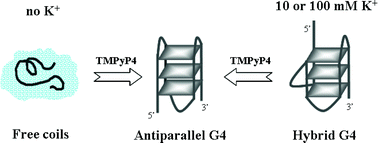We have performed systematic spectroscopic titrations to characterize the binding reaction of cationic meso-tetrakis(4-(N-methylpyridiumyl))porphyrin (TMPyP4) with the G-quadruplex (G4) of human telomeric single-strand oligonucleotide d[TAGGG(TTAGGG)3T] (S24), for which special effort was made to examine the TMPyP4-G4 binding stoichiometry, the binding modes, and the conformational conversion of the G4 structure under different potassium ion (K+) concentration. It is found that, in the presence of 0, 10 mM, and 100 mM K+, TMPyP4 forms a complex with the anti-parallel G4 in a TMPyP4-to-G4 molar ratio of 5, 5 and 3, respectively, and the increase of K+ concentration would reduce the binding affinity of TMPyP4 to G4. For the TMPyP4–G4 complex, the end-stacking mode and groove binding mode were presumed mainly by the results of time-resolved fluorescence spectroscopy in the three cases. Most importantly, it is found that TMPyP4 can directly induce the formation of the anti-parallel G4 structure from the single-strand oligonucleotide S24 in the absence of K+, and that it can preferentially induce the conformational conversion of the G4 structure from the hybrid-type to the anti-parallel one in the presence of K+.

You have access to this article
 Please wait while we load your content...
Something went wrong. Try again?
Please wait while we load your content...
Something went wrong. Try again?


 Please wait while we load your content...
Please wait while we load your content...